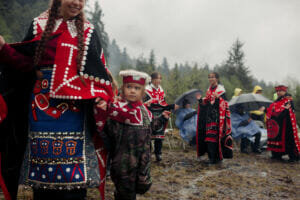Estimated Reading time

3 Mins
Mamalilikulla Debut Video Showcasing IPCA Declaration, Stewardship Aspirations
Since declaring an Indigenous Protected and Conserved Area in the Gwa̱xdlala/Nala̱xdlala Lull Bay/Hoeya Sound area of Knight Inlet, the Mamalilikulla have embarked on an ambitious plan to restore and protect their homeland.

Mamalilikulla First Nation is re-asserting its presence and stewardship responsibilities in the Nation’s traditional territory, which includes Compton Island, Village Island, and a portion of Gilford Island. In support of this important work, the Nation is working with partners, including Coast Funds, to increase their access to self-determined stewardship financing.
On November 29, 2021, Mamalilikulla First Nation declared an Indigenous Protected and Conserved Area (IPCA) in the Gwa̱xdlala/Nala̱xdlala Lull Bay/Hoeya Sound area of Knight Inlet, on the central coast of modern-day British Columbia. The IPCA covers 10,416 hectares of land and marine territory and includes fragile corals and sponges, critical habitat for 240 marine species, and salmon-bearing streams that have been degraded by industrial and commercial activities and landslides.
To celebrate their IPCA, the Mamalilikulla brought community members and partners to Gwa̱xdlala/Nala̱xdlala for a dedication ceremony on May 5, 2022. At the dedication, Hereditary and elected Chiefs, as well as leaders from neighbouring Nations, spoke about the importance of restoring and maintaining Indigenous Nations’ connection to the land, sea, and sky.

And, for the first time in over 100 years, Mamalilikulla people danced and sang at Gwa̱xdlala/Nala̱xdlala.
“We celebrated in the pouring rain,” recalls Winidi John Powell, elected Chief Councillor of Mamalilikulla First Nation, in a speech at the IMPAC5 forum, held in Vancouver. “The rain there was the tears of our ancestors. I think they would all be happy to see what we’re doing here today.”
In February 2023, the Government of Canada stood with Mamalilikulla First Nation to announce a marine refuge within the IPCA, protecting 2,123 hectares of marine habitat in the IPCA from all types of fishing. At the announcement, the federal fisheries minister at the time Joyce Murray noted that Gwa̱xdlala/Nala̱xdlala is the first marine refuge to be established by Fisheries and Oceans Canada within the Northern Shelf Bioregion (Great Bear Sea) Marine Protected Area Network planning process.
Land-based learning, language, culture, all of that can take place here.
The Mamalilikulla have plans to restore Gwa̱xdlala/Nala̱xdlala so that future generations will be able to fish and harvest there once again. And, beyond ecological restoration of important salmon and grizzly bear habitat, their IPCA helps protect important cultural and archaeological sites and creates opportunities for Mamalilikulla people, who have been dispersed, to reconnect with their homeland.
“That aspect of reconnection is incredibly important for our people. We could bring Elders here to teach our young people,” says Chief Powell. “Land-based learning, language, culture, all of that can take place here.”

The Mamalilikulla Guardians, who act as the “eyes and ears” of their Nation, play a critical role in monitoring and managing Gwa̱xdlala/Nala̱xdlala, and asserting the Nation’s presence and sovereignty.
From their dock in Port McNeill, the Guardians travel by boat to Gwa̱xdlala/Nala̱xdlala, where they monitor recreational and commercial activities, conduct research and restoration work on marine and terrestrial species, and carry out archaeological inventory work to learn more about how their ancestors lived.
Mamalilikulla’s traditional territory lies between the north-east coast of Vancouver Island and the mainland, extending from Matsui Creek and Nala̱xdlala in Knight Inlet, through Black Fish Sound, into Johnstone Strait. It’s a large area, with many islands and inlets, and it’s a challenge to cover the whole area.
The Mamalilikulla have built a strong vision for the future of Gwa̱xdlala/Nala̱xdlala, and are investing in their Guardian program’s future capacity.
To increase their stewardship capacity, Mamalilikulla First Nation is working with Coast Funds to secure contributions to its stewardship endowment, as part of an integrated plan to support First Nations on the coast with access to funding and finance, both for IPCA implementation and their long-term stewardship aspirations.
“The Mamalilikulla have built a strong vision for the future of Gwa̱xdlala/Nala̱xdlala, and are investing in their Guardian program’s future capacity,” says Ross Dixon, Coast Funds’ Director of Development. “At Coast Funds, we’re proud to be trusted to support the Nation in realizing its goals. We are hopeful that others will also invest, alongside the Nation, to ensure the Mamalilikulla have stable financial resources to carry out their traditional stewardship responsibilities.”
“Restoration needs to happen in [Gwa̱xdlala/Nala̱xdlala] and we need the money and the resources to be able to build that capacity,” emphasizes Chief Powell.
To learn more about how you can support the Mamalilikulla IPCA implementation and Guardian programs, contact Ross Dixon (ross@coastfunds.ca).
